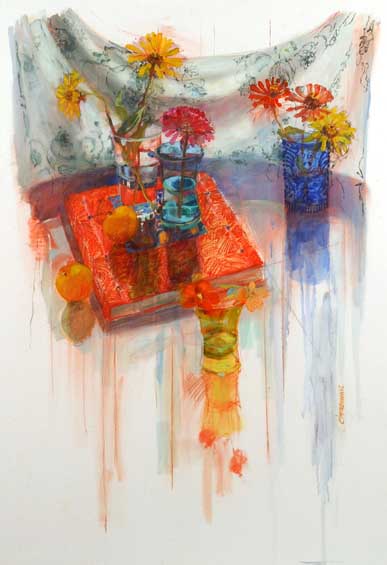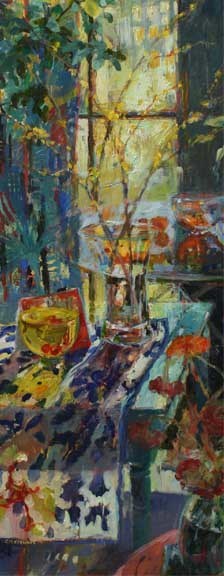What’s New
A Living Art
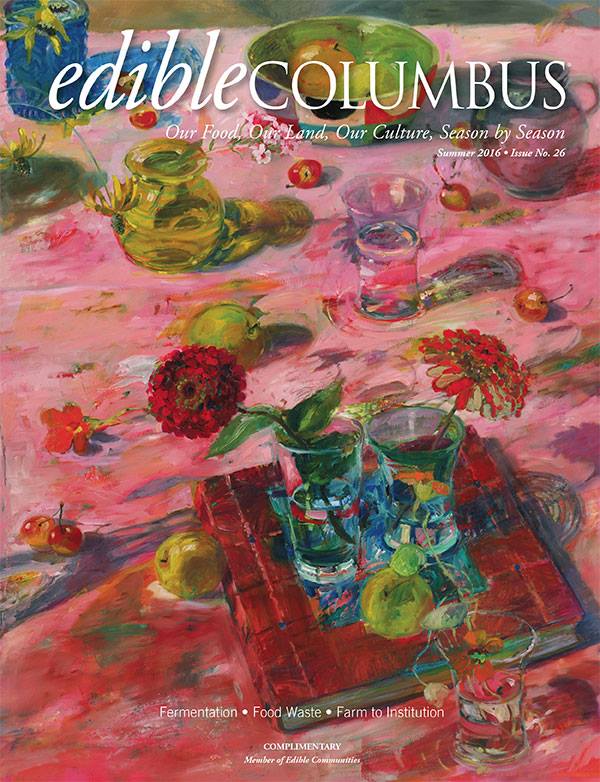 Carol Stewart’s still-life paintings offer a riot of colors and friendly objects including vases, glassware, fruits, flowers and textiles — all assembled as if on a theatrical stage. “Tablescapes,” echoing concepts found in landscape paintings, is the ideal title of her exhibit at the Ohio State University Faculty Club. Some 20 oil paintings are presented in the exhibit by the Bexley artist, who is represented by Hammond Harkins Galleries and maintains a studio at the Milo Arts center. “My studio has a southern exposure, so there’s lots of light,” Stewart said. “I’m interested in color and light and light falling on objects.”
Carol Stewart’s still-life paintings offer a riot of colors and friendly objects including vases, glassware, fruits, flowers and textiles — all assembled as if on a theatrical stage. “Tablescapes,” echoing concepts found in landscape paintings, is the ideal title of her exhibit at the Ohio State University Faculty Club. Some 20 oil paintings are presented in the exhibit by the Bexley artist, who is represented by Hammond Harkins Galleries and maintains a studio at the Milo Arts center. “My studio has a southern exposure, so there’s lots of light,” Stewart said. “I’m interested in color and light and light falling on objects.”
Read A LIving Art by Colleen Leonardi published in Edible Columbus – Summer 2016
Still-life painter Carol Stewart makes ordinary items dramatic
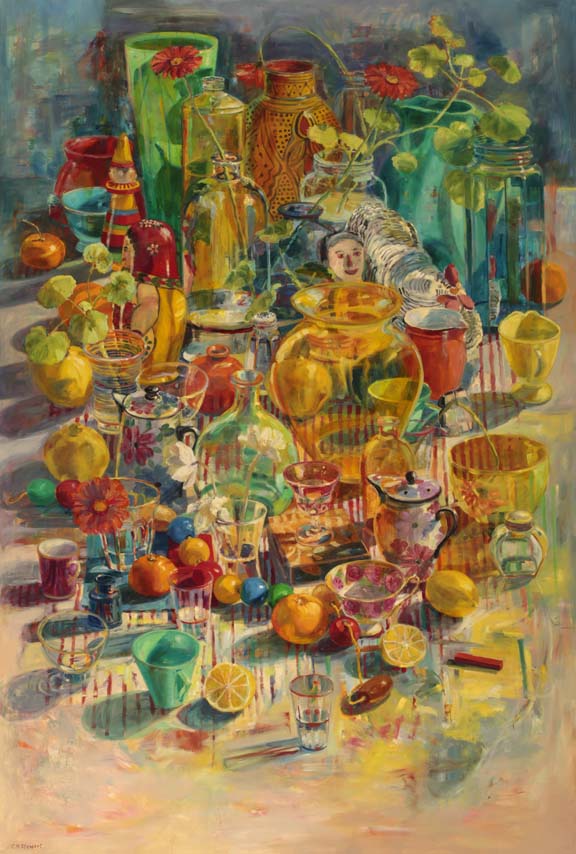 Carol Stewart’s still-life paintings offer a riot of colors and friendly objects including vases, glassware, fruits, flowers and textiles – all assembled as if on a theatrical stage.
Carol Stewart’s still-life paintings offer a riot of colors and friendly objects including vases, glassware, fruits, flowers and textiles – all assembled as if on a theatrical stage.
By Nancy Gilson, Columbus Dispatch
Carol Stewart’s still-life paintings offer a riot of colors and friendly objects including vases, glassware, fruits, flowers and textiles — all assembled as if on a theatrical stage.
“Tablescapes,” echoing concepts found in landscape paintings, is the ideal title of her exhibit at the Ohio State University Faculty Club.
Some 20 oil paintings are presented in the exhibit by the Bexley artist, who is represented by Hammond Harkins Galleries and maintains a studio at the Milo Arts center.
“My studio has a southern exposure, so there’s lots of light,” Stewart said. “I’m interested in color and light and light falling on objects.”
Stewart, a native of Ontario, Canada, moved several years ago from St. Louis to central Ohio with her husband, Paul Goodfellow, a researcher at OSU’s James Comprehensive Cancer Center. Their travels together provide fodder for some of Stewart’s paintings. Textiles from India, for example, are found along with clear glass vases in “Patterns from India,” and Chinese lanterns from San Francisco abound in “Paper Lanterns I.”
Stewart seems fascinated by common but lovely everyday items. She often paints flowers that she has grown outside her studio, as in “Hellebores.”
“Late Afternoon February,” one of her most recent works, focuses on items she unpacked from boxes: pitchers, vases, a salt shaker, dolls, toys and more which, together, acquire a feeling of abstraction because of their dense concentration.
Two works pay tribute to one of her own favorite painters, the deceased Richard Diebenkorn, an abstract expressionist and member of the Bay Area Figurative Movement. Stewart includes references to his paintings in “Still Life with Diebenkorn” and “Still Life with Diebenkorn and Clementine.”
One of the most beautiful works is “Three Green Pitchers,” a study of pitchers, cups, bowls, lemons and boxes artfully assembled on a table and painted in vivid shades of green, rose and blue.
Stewart’s paintings are exceptionally pleasant to look at, but they are more than pretty. Her composition is careful and imaginative. And her sophistication with color and light might look effortless but is deceptively skillful.
The Ohio State Fair: August 2015, 2 prizes
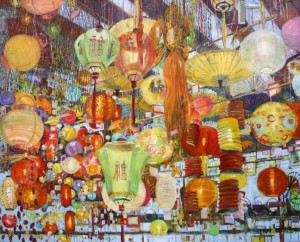 “While not new to painting, Carol Stewart is relatively new to Ohio. For that we should be grateful. Her two works included in this year’s exhibition demonstrate an artist of exceptional skill in both large format painting and small. Bottled Peaches, Blood Orange offers a still-life that is deft, sure-handed, and intimate. The palette is restricted to mostly reds, oranges, and some subdued greens. Conversely, Paper Lanterns is ambitious, sprawling, and kaleidoscopic. While ostensibly about lanterns, this work is just as much about paint and the nearly limitless ways it can be applied to the canvas. The end result is an advanced lesson in color, harmony, scale, repetition, and pattern.” (see full review by Jeff Regensburger here)
“While not new to painting, Carol Stewart is relatively new to Ohio. For that we should be grateful. Her two works included in this year’s exhibition demonstrate an artist of exceptional skill in both large format painting and small. Bottled Peaches, Blood Orange offers a still-life that is deft, sure-handed, and intimate. The palette is restricted to mostly reds, oranges, and some subdued greens. Conversely, Paper Lanterns is ambitious, sprawling, and kaleidoscopic. While ostensibly about lanterns, this work is just as much about paint and the nearly limitless ways it can be applied to the canvas. The end result is an advanced lesson in color, harmony, scale, repetition, and pattern.” (see full review by Jeff Regensburger here)
New vitality discovered in an old genre
by Christopher A. Yates for the Columbus Dispatch
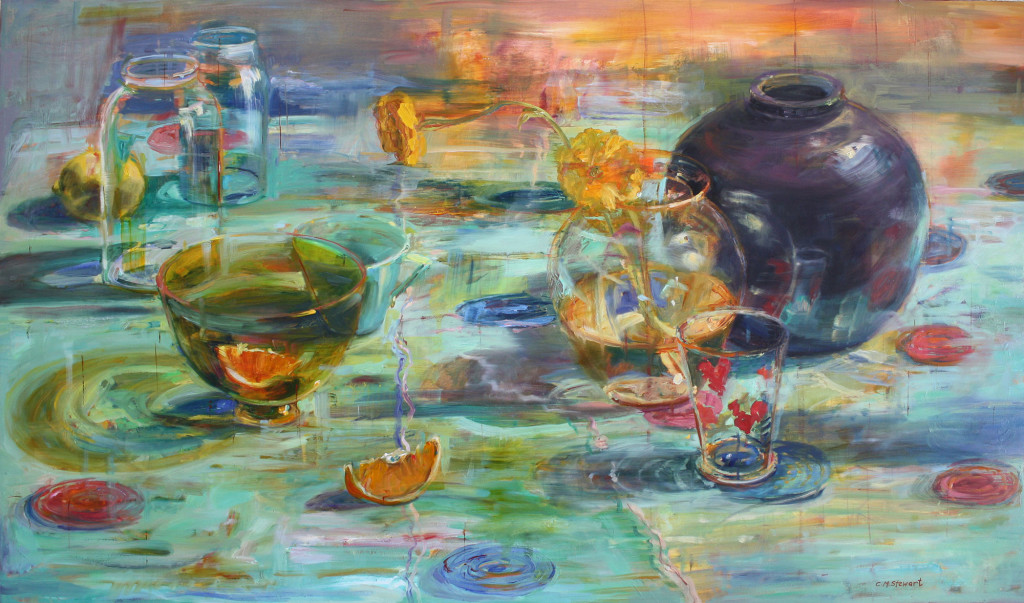 Still-life paintings mix realism with bold harmonies of bright colors
Still-life paintings mix realism with bold harmonies of bright colors
Carol Stewart’s still-life paintings are studies of light, pattern and color.
With decorative extravagance and a sense of play, each piece features numerous cups, vases, fruits and flowers arranged upon brightly colored draperies.
Stewart, born in Canada, received her Bachelor of Fine Arts degree in 1981 from Queens University in Kingston, Ontario; and her master’s in 2010 from Fontbonne University near St. Louis, where she lived and worked for many years. She recently moved to central Ohio.
Her paintings are over-the-top explorations that mix gesture and realism. Traversing her compositions from cup to cloth to vase, one discovers repeated shapes and surprising color harmonies in objects that are otherwise benign.
Some works are inspired by travel. Patterns From India has a celebratory air in terms of its palette and intensity. By focusing on the transparency of glass, Stewart plays hide-and-seek with viewers. Space seems tenuous as one examines background objects through ones in the foreground.
The polka dots on the drapery in Polka Dot Painting are seen through transparent objects and look like confetti.
Directional light helps order the chaos in Pink Painting.
Stewart is at her best when the energy of her mark envelops her still-life objects in an atmospheric haze. In Two Ranunculus, a green drapery swallows up forms, creating a dreamlike space open to interpretation.
Whether poetic explorations or simple records of daily life, the still life has a long, rich history.
Stewart’s paintings, pleasant and comfortable, are essentially records of experience.
Be Still – Article in City Scene
 by Lisa Aurand
by Lisa Aurand
Flowers, vases and textiles are the vehicles for painter’s fascination with color and light
Carol Stewart has a quiet manner about her. In her studio on the south side of the Milo Arts center, she works for seven or eight hours a day on her still life oil paintings as she listens to classical music or jazz.
She arranges jars, pots, vases, boxes, flowers and fruits; adjusts studio lights that mimic sunlight; and, of course, paints. Color, light, transparency and the marks of the brush on the page are her main modes of communicating with the viewer, Stewart says.
Canadian by birth, Stewart came to Columbus via St. Louis two years ago, following her geneticist husband, who took a position as a cancer researcher at The Ohio State University.


